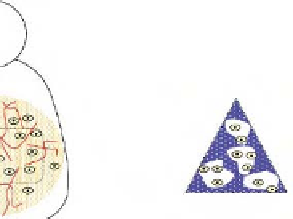Biomedical Engineering Reference
In-Depth Information
a delivery system for bioactive agents, such as growth
factors; (9) a geometry which promotes formation of the
desired, anisotropic tissue structure; (10) a processable
and reproducible architecture of clinically relevant size
and shape; (11) sterile and stable enough for shelf life,
transportation, and production; and (12) economically
viable and scaleable material production, purification,
and processing.
Scaffolds initially fill a space otherwise occupied by
natural tissue, and then provide a framework by which
a tissue will be regenerated. The architecture of 3-D
scaffold can also control vascularization and tissue in-
growth
in vivo.
In this capacity, the physical and bi-
ological properties of the material are inherent in the
success of the scaffold. Selection and synthesis of the
appropriate scaffold material is governed by the intended
scaffold application and environment in which the scaf-
fold will be placed. For example, a scaffold designed to
encapsulate cells must be capable of being gelled without
damaging the cells, must allow appropriate diffusion of
nutrients and metabolites to and from the encapsulated
cells and surrounding tissue, and stay at the site of im-
plantation with sufficient mechanical integrity and
strength. Scaffold heterogeneity has been shown to lead
to variable cell adhesion and to affect the ability of the
cells to produce a uniform distribution of ECM. Tissue
synthesized in a scaffold with non-uniform pore archi-
tecture may show inferior biomechanical properties com-
pared to tissue synthesized in a scaffold with a more
uniform pore structure. In scaffolds with equiaxed pores,
cells aggregate into spherical structures, while in scaf-
folds with a more elongated pore shape, cells align with
the pore axis.
Once the scaffold is produced and placed, formation
of tissues with desirable properties relies on scaffold
mechanical properties on both the macroscopic and the
microscopic levels. Macroscopically, the scaffold must
bear loads to provide stability to tissues as it forms and
to fulfill
Without
scaffolds
Cell therapy
(internal medicine)
Regenerative
medicine
With
scaffolds
Tissue engineering
(surgery)
Fig. 7.2-1 Classification of regenerative medicine based on the
use of scaffold.
Scaffolds should encourage the growth, migration, and
organization of cells, providing support while the tissue is
forming. Finally, as demonstrated in
Fig. 7.2-2
, the
scaffolds will be replaced with host cells and a new ECM
which in turn should provide functional and mechanical
properties, similar to native tissue. The material and the
3-D structure of scaffolds have a significant effect on
cellular activity. Depending on the tissue of interest and
the specific application, the required scaffold material
and its properties will be quite different. In general,
a biologically active scaffold should provide the following
characteristics: (1) a 3-D, well-defined porous structure
to make the surface-to-volume ratio high for seeding of
cells as many as possible; (2) a physicochemical structure
to support cell attachment, proliferation, differentiation,
and ECM production to organize cells into a 3-D archi-
tecture; (3) an interconnected, permeable pore network
to promote nutrient and waste exchange; (4) a non-toxic,
bioabsorbable substrate with a controllable absorption
rate to match cell and tissue growth
in vitro
or
in vivo,
eventually leaving no foreign materials within the
replaced tissues; (5) a biological property to facilitate
vasculature network formation in the scaffold; (6) me-
chanical properties to support or match those of the
tissue at the site of implantation and occasionally to
present stimuli which direct the growth and formation of
a load-bearing tissue; (7) a mechanical architecture to
temporarily provide the biomechanical structural char-
acteristics for the replacement ''tissue'' until the cells
produce their own ECM; (8) a good carrier to act as
its volume maintenance function. On the
Ex vivo
tissue engineering
In situ
tissue engineering
Fig. 7.2-2 Role of scaffold in tissue engineering.













